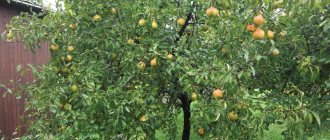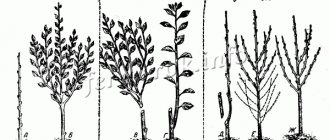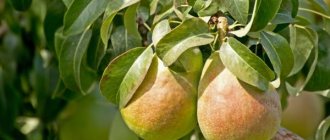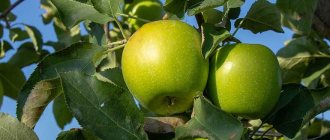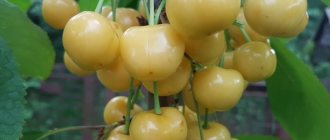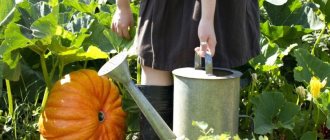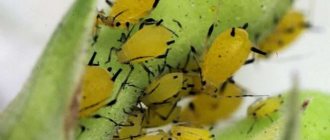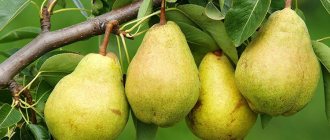History of origin
The Allegro pear was the result of very successful artificial pollination of the Autumn Yakovleva variety, well known to gardeners, so it is not afraid of frost, temperature fluctuations and has good resistance to most plant pests and diseases.
More than 15 years ago, Russian breeders created a mid-season variety that survives in cold conditions, which was called Allegro. This is one of the few fruit trees whose cultivation became possible thanks to artificial pollination by the “Osennyaya Yakovleva” apple tree.
The newly introduced variety was included in the State Register in 2002 and was recommended for trial planting in the Central Black Earth region. Since then, the tree has been actively planted in most parts of the country, surprising with fruits with excellent taste and universal purpose. Pear Allegro was the result of the work of scientists: Yu.K. Ilyina, S.P. Yakovleva and S.S. Yakovleva.
Pear Allegro
Climate and cultivation regions
Allegro is a winter-hardy variety that can withstand fairly low winter temperatures.
It also tolerates drought and temperature changes well, therefore, fruit trees of this species are cultivated not only in the south and in the Black Earth Region, it also thrives in more temperate latitudes - the Central region and Central Russia, including the Moscow region.
Reviews from gardeners
Before you go shopping for seedlings, you should listen to the opinions of experienced summer residents who will help you make an objective and informed choice.
Olga, Samara: “Very tasty and juicy pear. It’s also quite beautiful, so it will perfectly decorate any table. The pulp is sweet and sour, with notes of Astrakhan watermelon and a hint of buckwheat honey. In general, Allegro has been pleasing my family with a rich harvest for 10 years.”
Natalya, Vologda: “I am amazed by the winter hardiness of this variety. Despite severe frosts, Allegro is perfectly preserved and is practically not susceptible to fruit rot or scab.”
Alexander, Tula: “The Allegro pear has been growing in my garden for 7 years. 2 years ago it began to bear fruit abundantly. Its impeccable taste determines the variety’s exceptional versatility in use, and its attractive appearance allows you to easily sell surplus.”
So, the domestic Allegro pear variety is deservedly popular among Russian gardeners. Thanks to its resistance to cold weather, this tree can be grown outside the Central Black Earth District, which certainly pleases residents of the middle zone. Perhaps the only significant drawback is the short shelf life of the fruit. However, it can be significantly increased through conservation.
Description of Allegro pear
The Allegro pear was the result of very successful artificial pollination of the Autumn Yakovleva variety, well known to gardeners, so it is not afraid of frost, temperature fluctuations and has good resistance to most plant pests and diseases.
The description of the variety characterizes the pear tree as medium-sized, fast-growing, with a slightly drooping crown. Mixed fruiting. Removable fruit ripeness occurs in early August, and the average duration of the consumption period does not exceed two weeks. The pear tree begins to bear fruit approximately in the fifth year after planting, which makes it possible to classify the Allegro variety as relatively early-bearing.
The fruits of this pear variety are medium-sized, weighing about 110-145 g, elongated pear-shaped, covered with delicate and smooth skin. The coloration at the removable maturity stage is greenish, with a slight pink tan. The peduncle is long, curved, with an oblique arrangement.
The pulp is white, very tender, with average density and not too pronounced fine grain. There is no astringency or granulation at all, the taste is sweet and is rated by tasters at least 4.5 points.
Description of the tree
The shoots are light brown in color and wavy in shape. The stalk is small. The leaves are oval with a pointed end and sawtooth edges. The color of the leaves is not the same from different sides - shiny dark green on the outside, matte and lighter on the inside.
The pear grows quite quickly, although it does not begin to bear fruit soon. The crown is not thick and not too voluminous. The branches are slightly bent to the ground and have a slightly curved shape.
Description of fruits
The average weight of one fruit is 130-140 g. The shape is oval, pointed towards the top. The skin is very thin and shiny, pale green in color with a slight pink tint. When ripe, the green color slowly turns into yellow, and the pink turns into small burgundy “cheeks”. The pulp is white, soft and very juicy. Like the donor variety, Allegro has a very pleasant taste, sweet without any signs of astringency. Pears also have a strong and pleasant aroma that is unique to no one else.
The fruits retain their taste and presentation for two weeks, but they need to be stored in the refrigerator or at least covered with something on top, otherwise you risk acquiring a flock of very persistent “fans” - wasps and moths. The culture is universal, it is perfect for consumption immediately after picking from the pear and for making jams, preserves, etc. In addition, during the ripening of fruits you need to be very careful - these fruits tend to overripe quickly, becoming too soft and not very tasty, so you need to harvest the crop at a time when it is still a little ripe, this will slightly increase its shelf life .
Pear flavor
A distinctive feature of each variety, of course, is its taste characteristics. The selection variety Allegro received a sweet taste without astringency and granulation, rated by tasters at 4.5 points. It is worth mentioning separately the strong, pleasant and characteristic aroma that makes this variety well recognizable.
Application area
The sweet pear fruits are most often picked to be enjoyed fresh. But they can also find other uses - ripe pears are perfect for making preserves, jams, and marshmallows. The gradual ripening of tasty fruits allows them to be consumed in various forms.
Characteristics of the Allegro pear variety
The description suggests that the crop grows of medium size - around 3 m in height. The main fruiting period is August. The fruits ripen unevenly, allowing you to enjoy fresh fruit for a whole month. Productivity is consistently high. Fruiting begins in the fifth year after planting.
The variety is not capable of self-fertilization, so before planting you should make sure that there are pollinators nearby. These may be the summer pear varieties Augustovskaya Kosa and Chizhikovskaya. Apple trees with early flowering and fruiting are excellent pollinators.
Winter hardiness
"Allegro" copes well with winter frosts. There are known cases of successful wintering at a temperature of – 36 °C. It should also be noted that it is resistant to temperature changes, for example, in spring or autumn. But, despite its resistance to cold, experienced gardeners recommend covering the tree trunk with whitewash, for example, Bordeaux mixture, in spring and autumn. This procedure is done to prevent sunburn and possible consequences from sudden temperature changes.
Did you know? Pear wood is used to make furniture, musical instruments and even kitchen appliances. Wood is good because it is not saturated with odors, does not deform, and also withstands the water test very well.
Drought resistance
Allegro has good drought resistance. This variety does not need frequent watering. It is enough to water the trees at the rate of 3 liters of water per 1 tree, do this several times in the spring and several times in the summer. In dry summers, the amount of watering can be increased.
Resistance to environmental conditions and diseases
This variety demonstrates a high level of resistance to environmental conditions. “Allegro” will not be afraid of sharp temperature fluctuations in early spring or late autumn. Among fungal diseases, the tree has good resistance to scab.
By the way, increased resistance to fungal diseases allows you to minimize the chemical treatment of the garden, which means that an environmentally friendly product will end up on your table.
Flowering period
Flowers appear in early spring, after the air temperature has become steadily warm. Don't worry that frost will prevent flowering - resistance to temperature changes also extends to the flowers.
Did you know? Before tobacco was brought to Europe, Europeans smoked pear leaves.
Pollinators for Allegro pear
The Allegro variety is a self-sterile variety. Therefore, to obtain a tasty and abundant harvest, additional planting of pollinating pears is necessary. Experienced gardeners advise planting pollinating varieties such as “Augustovskaya Rosa” or “Chizhovskaya” for the “Allegro” pear.
Important! When choosing a companion Allegro pear for pollination, pay attention to the period of flowering and fruit formation - these indicators should be the same for the selected varieties.
Maturation period
The first fruits ripen in mid-August. After collecting the first fruits, you can let them sit for 2 weeks until they reach consumer maturity. Due to this ripening, their color will change slightly - a yellowish tint will appear, and the flesh will become very soft. Uneven ripening on one tree allows the ripening period to be extended until the end of August.
Fruiting
The Allegro variety is characterized by a mixed type of fruiting, which means the possibility of setting fruit both on fruit twigs, spears, and on annual shoots. Thanks to this feature, the Allegro pear will be able to please you with a bountiful harvest. Planted trees begin to bear fruit 4–5 years after planting in a permanent place.
Productivity
The productivity of Allegro is high; already in the first fruitful year you can collect at least 10 kg of pears from one tree. In subsequent years, with proper care, this variety will delight you with a stable 8–12 kg per season. Agree that this is a considerable indicator for medium-sized varieties.
Important! Proper watering will help increase productivity. By installing a drip irrigation system, you can significantly improve the quality of your crop.
Lighting requirements
If you seriously decide to grow the Allegro pear in your garden, then choose the right place for planting. Pears prefer well-lit, sunny areas. Choose a location on the west or southwest side of the garden. Despite its love for the sun, it is advisable that the tree is not exposed to the hot sun throughout the day. A light shadow, for example, from tall neighbors in the garden will be just right.
Advantages and disadvantages
The variety has long become popular among gardeners. And all thanks to its significant list of indisputable advantages, among which it should be noted:
- Precocity. Typically, the tree begins to bear fruit 5 years after planting.
- High yield due to its belonging to the mixed type (up to 10 kg per year from one pear).
- Regularity of fruiting.
- Excellent resistance to unstable weather conditions, for example, to a significant decrease in ambient temperature.
- Resistance to a number of diseases, including powdery mildew and scab.
- Uneven fruit ripening, which allows fully ripe pears to be processed gradually and slowly.
- Good commercial qualities (weight, shape, color, etc.)
- Wonderful taste, as close as possible to dessert.
Description of the variety and its characteristics
The variety was created in 1999 by breeders S. Yakovlev, S. Yakovleva and Y. Ilyina from the Osennyaya Yakovleva pear variety at the All-Russian Scientific Research Institute of Genetics. In 2002, the Allegro pear was included in the State Register of our country for cultivation in the Central Black Earth region.
Description of the tree
A tree of this type will decorate any summer cottage with dignity, thanks to its high decorative effect:
- it grows of medium size and has a beautiful rounded crown;
- it is characterized by a high growth rate, however, this does not affect the beginning of fruiting - the tree begins to bear fruit only in the 5th year of growth;
- branches are beautiful, powerful, slightly curved to the bottom;
- the outer side of the large, glossy oval leaves pointed at the ends is dark green. The back side is much lighter, matte, with a slight edge;
- flowers are large, white or pale pink. Flowering is abundant, occurs at the end of May and lasts about 10 days;
- the variety requires the presence of additional pollinators nearby, which are the Chizhovskaya and Avgustovskaya Rosa varieties.
Description of fruits
Allegro fruits look truly amazing:
- medium or large, weighing 140-180 g, they have a beautiful pear-shaped shape and a yellowish color with a delicate, elegant pink blush;
- the white juicy pulp of the fruit is covered with a thin, delicate skin;
- the taste of the fruit is very sweet, rich, without any aftertaste;
- pears have an unsurpassed aroma;
- Allegro is characterized by a high sugar content and low acid content.
100 g of pulp contains:
- sugars - about 8.5%;
- acids - 0.6%;
- vitamin C - 8 mg;
- active substances - 50 mg;
- dry ingredients - about 15%.
On a five-point scale, taste qualities are rated at 4.5 points.
Usage
Fruits of this variety are very tasty fresh. Both children and adults love to eat them. Juices and jams are prepared from fruits, preserves are made, products are made, they are dried and frozen. The fruits are used in pies as a filling, and are also added to desserts and fruit salads.
Ripening and harvesting dates
Allegro pear is an early ripening variety. The fruits begin to ripen in mid-August. The fruits do not ripen all at once, but gradually over the course of a month, so you can eat them over several weeks. Harvesting occurs as the fruits ripen.
It is not recommended to delay harvesting - overripe fruits lose their presentation and taste.
Productivity
Trees begin to bear fruit in full 5–7 years after planting, however, the first fruits may appear earlier. From one mature tree aged 8 years and older, 9–13 kg of fragrant pears are harvested.
Harvest shelf life and transportability
The harvested crop is not stored for long, a maximum of 10-14 days in the refrigerator, therefore, it is recommended to process the fruits immediately after they are removed from the tree. If it is necessary to increase the shelf life, the fruits are harvested a couple of weeks before the ripening date.
The fruits of the Allegro variety are poorly transported over long distances - they lose their taste and appearance.
Rules for planting Allegro pears
After proper planting, the tree develops quickly and begins to bear fruit generously on time.
Warning! It is better to place a pear tree once, because in adulthood all varieties do not tolerate transplantation well.
Recommended timing
The seedling is placed from the beginning of September to October 5-7. Spring planting is carried out from April to May 10, until the buds bloom.
Attention! Garden soil is well loosened, since powerful roots that grow up to 5-7 m require free access of air and moisture.
Selection and preparation of seedlings
It is better to buy young pears, up to 3 years old. Afterwards, the pear tree takes root rather poorly. In the south, annuals are planted. When buying an Allegro pear, you also buy pollinating varieties that bloom at approximately the same time as it, preferably summer varieties. Select seedlings with an elastic trunk and roots, without damage, with large, living buds. There are several shoots on the roots.
Site selection and soil preparation
When planning to plant a pear, carefully consider the placement. Select by criteria:
- sunny spacious area, without shading by trees or buildings;
- small hills;
- groundwater below 2 m;
- The Allegro variety develops well on chernozems or loams.
The place for the pear is prepared six months or at least a week before planting, and the substrate is laid. The diameter of the pit is 60-80 cm, the depth is 80-100 cm. Prepare for the substrate:
- 20-30 liters of compost;
- 10-15 liters of sand;
- half the volume - garden soil;
- 120-150 g of superphosphate;
- 60 g of potassium sulfate powder.
The substrate is placed in a hole, then spilled with lime water (per 10 liters - 300 g of slaked lime or dolomite flour). Add another 20 liters of water. For spring planting of pears, it is recommended to lay the substrate at the end of October, before frost.
Landing algorithm
Before planting, the seedling is soaked in a clay mash for 24 hours. To stimulate root formation, many gardeners add 20 g of honey per 10 liters of water or one tablet of the drug Heteroauxin to the mash.
Part of the compacted substrate is removed and the pear is planted:
- form a mound from the soil remaining in the pit;
- drive the support stake at a distance of 15-20 cm from the center;
- the roots of the seedling are spread on a mound and sprinkled with the prepared substrate;
- the root collar is 5 cm above the garden surface;
- the trunk is attached to the support pole;
- compact the soil, form an earthen rampart around the pit so that water does not spill throughout the garden;
- water with 20-30 liters of water, mulch with compost and humus.
Attention! In dry weather in autumn and spring, seedlings are watered once a week with 20-30 liters of water.
Landing
In order for the Allegro pear to grow well and bear fruit with dignity, the following conditions must be observed when planting:
- you need to choose the right site - the place should be well lit and protected from the wind;
- Allegro loves good fertile soil;
- groundwater should not come closer than 2.5 meters to the soil surface;
- seedlings are planted either in the spring, after the soil has warmed up properly, or in the fall, before the first frost occurs;
- prepare the site ahead of time - dig up the soil, free it from weeds and roots, add fertilizers - organic matter and mineral complexes;
- then make a hole 50 cm deep and 1 m in diameter, which is filled halfway with the top fertile layer mixed with rotted mullein, superphosphate and wood ash;
- a small elevation is made on top of the layer, on which the seedling is placed and the roots are straightened;
- the tree is covered with the remaining soil, which is compacted and watered abundantly;
- the distance around the seedling is covered with mulch - peat, humus or rotted manure.
Aftercare
The Allegro variety is quite drought-resistant, so seedlings are often watered only once a week. Trees are watered before flowering and during the formation of ovaries, 3-4 times during the summer. The tree trunk circle is loosened and weeds are removed. Feed the pear twice:
- in April-May, nitrogen preparations and organic matter are introduced;
- in August - organic matter, phosphorus and potassium products.
In summer and autumn, sanitary pruning is carried out, freeing the tree from damaged branches. In early spring, from the age of 3-4 years, the crown begins to form. In late autumn, the pear trunk is whitened, which promotes the survival of the tree in conditions of temperature changes, and also serves as preventive protection against pests. With the onset of frost, young pears are protected from rodents by installing special nets or a thick layer of paper or burlap around the trunk. Mulch is poured under the seedlings.
Watering
In addition, the tree needs watering. If the summer was not too dry and hot, then 4-5 waterings for the season will be enough. Otherwise, the plant will need more water, depending on temperature and rainfall. Watering is best done by sprinkling, simulating natural precipitation, but you can pour water directly under the trunk. With the last method of watering, you must remember that Allegro does not like water standing near the trunk for a long time - its excess should be drained using drainage channels. After the water has subsided, it is necessary to loosen or mulch.
Top dressing
The crop is fed 2-3 times a year. Before the buds open, add a solution of urea or mullein. Fertilizers contain nitrogen, which will ensure active growth of shoots. After flowering, prepare a solution of Nitroammophoska in a ratio of 1:20. At the stage of fruit ripening, pears are fed with phosphorus-potassium compounds.
Whitewash
Another danger is sudden temperature changes. Both young shoots and already formed ovaries can suffer from such changes. Experienced gardeners recommend the following way to combat this - in spring and autumn, whitewash with a mixture of water-based paint and Bordeaux mixture.
Trimming
Carrying out this agrotechnical procedure allows you to prolong the life and stimulate fruiting of the tree.
Pruning is done for:
- young, one- and two-year-old seedlings, which are shortened before planting;
- ovaries in young trees, which are partially removed (this manipulation helps stimulate tree growth and improve the quality and volume of the harvest);
- growth on seedlings, which in the future can increase the fertility of the tree by almost 20–30%.
Allegro pear: description of the variety, planting and further care at home, photo
One of the results of modern breeding work by Russian scientists is the summer table pear variety Allegro, the appearance of which was based on the attractive characteristics of the Osennyaya Yakovleva variety as a result of its pollination. Read more about this variety and caring for it later in the article.
Pear flavor
A distinctive feature of each variety, of course, is its taste characteristics. The selection variety Allegro received a sweet taste without astringency and granulation, rated by tasters at 4.5 points. It is worth mentioning separately the strong, pleasant and characteristic aroma that makes this variety well recognizable.
Pollinators
The Allegro variety is self-sterile and needs to be in the vicinity of pollinators, which can be pears of the Avgustovskaya Rosa and Chizhikovskaya varieties, as well as early apple trees.
Important! In pollination, the main thing is that pollinating trees bloom at the same time as the pollinated tree, and also belong to the same group according to the timing of crop ripening.
Pros and cons of the variety
Since the variety was bred through breeding work, its positive characteristics predominate, and the negative qualities were leveled out as much as possible.
- The benefits include:
- good resistance to low temperatures and daily fluctuations on the thermometer;
- large harvest volume (up to 10 kg per year from one medium-sized tree);
- excellent taste characteristics;
- high immunity to pests and characteristic diseases;
- gradual rather than rapid ripening of pears;
- excellent commercial qualities: attractive appearance, shape, color.
- The disadvantages include:
- short shelf life after picking (no more than a week), if the fruit was picked well-ripened;
- the need to plant pollinator trees nearby.
Planting and care
Compliance with planting technology is a very important condition, the fulfillment of which plays a big role in the process of growing crops. After planting, the tree also needs proper and regular care, which includes:
- monitoring the condition of the soil, loosening it, adding nutrients;
- timely watering;
- pruning branches;
- whitewashing the trunk in spring and autumn, which helps the tree more easily withstand temperature changes;
- preparing the tree for wintering.
Optimal growing conditions
The Allegro pear, like many other fruit trees, prefers sunny places without strong, draft winds.
The best option is the western or southwestern side of the garden plot.
The tree can spend part of the day in the shade or partial shade from neighboring buildings or higher neighbors, which is preferable to prolonged exposure to the scorching rays of the sun.
If the planting site is located in an area where groundwater flows quite close to the surface (less than 2 m), then before planting the tree it is recommended to create a small earthen mound, since the root system of the pear is well developed and can penetrate deep into the soil to a depth of 5–7 m, and contact with water and stagnation of moisture in the soil can destroy a pear tree.
Important! The pear does not like to grow next to the red rowan, since this tree has the same pests as the pear.
The soil should be:
- black soil or loam;
- light, loose;
- breathable;
- moisture-permeable.
Preparations for planting begin well in advance. So, if they plan to plant a pear in the spring, then preparatory work begins in the fall, and vice versa - for autumn planting. Depending on the climatic characteristics of the region, pear planting may occur a little earlier or later, but on average, a tree seedling is planted in late March–early April, when the average daily air temperature does not fall below +5°C. It is important to catch it before the leaves bloom. Autumn planting is usually carried out at the end of September–beginning of October, but no later than 3 decades, so that the seedlings have time to take root and adapt before the onset of the first frosty days.
Landing rules and technology
To plant a seedling, you need to dig a hole about 50 cm deep and twice as large in diameter (about 1 m).
A nutrient layer is placed at the bottom of the recess, which will occupy 2/3 of the total volume and may consist of:
- chernozem - 1.5 buckets;
- manure - 10 kg;
- ash;
- superphosphate.
Before planting, the top of the seedling must be trimmed so that its total height does not exceed 1 m, and the roots must also be trimmed, which are shortened by 10 cm.
The seedling is immersed in the hole in such a way as not to deepen the root collar too much. After planting the seedling, it must be secured in the planting hole using pegs and rope.
The soil around the trunk, in the tree-trunk circle, is generously filled with water, compacted and mulched.
You can use the following as mulch:
The soil should remain well moistened and retain this nutrient moisture for a long time, but the tree trunk circle should not be over-watered to prevent rotting of the roots.
Watering and fertilizing
For good growth and development of a tree, it is necessary to provide it with nutrients. On average, the number of feedings per season is 4–5, with sufficient watering and not too hot weather.
Watering is optimally carried out by sprinkling, when natural precipitation is imitated, but watering under the trunk is also allowed. You should know that Allegro does not like stagnation of water near the trunk, therefore, to drain the water it is necessary to create a network of drainage channels. On average, the amount of water for 1 tree is 3 liters.
In the spring, the tree is irrigated several times; in the summer, when temperatures are too high, watering is done a little more often than several times per season, especially if the summer is dry. After moistening the soil, it is necessary to loosen the top layer and mulch, which helps retain moisture in the soil.
The soil is not fertilized in the first season after planting, since there is already a sufficient amount of nutrients in the planting hole.
Subsequently, fertilizers are applied twice:
- in the spring season - mineral, nitrogen-containing substances that promote good growth and fruiting;
- in the autumn season - organic: cow manure, chicken droppings.
It is possible to fertilize before flowering, when zinc sulfate is added to the soil, which can increase yield by 10%.
We recommend that you learn how to dry pears at home.
Trimming
Carrying out this agrotechnical procedure allows you to prolong the life and stimulate fruiting of the tree.
Pruning is done for:
- young, one- and two-year-old seedlings, which are shortened before planting;
- ovaries in young trees, which are partially removed (this manipulation helps stimulate tree growth and improve the quality and volume of the harvest);
- growth on seedlings, which in the future can increase the fertility of the tree by almost 20–30%.
Pear pruning diagram.
Diseases and pests
The Allegro pear tree is not susceptible to most diseases characteristic of this type of plant, since it was bred through selective breeding, during which scientists minimized the risk of their occurrence.
Thus, cracks may occur on the tree, which can be mistaken for signs of disease, but this is the result of mechanical or temperature effects.
Such cracks can become a path for diseases and pests to enter a living organism, so their condition must be carefully monitored and cleaned.
To do this, you will need to take a solution of 1% Bordeaux mixture and treat the cracks with it using a metal brush, and then cover the crack with a special putty or clay. Allegro has immunity against fungal diseases and scab. To prevent the occurrence of diseases and pests, it is recommended to carry out timely removal of weeds, fallen leaves and crumbled crops.
Harvest and storage
Allegro begins to ripen by the beginning of August, so you can find mentions of the variety among the early ones.
The fruits ripen gradually and unevenly, which is convenient for private collection and processing in small quantities.
The fruits can quickly become overripe, so they must be removed from the tree in an unripe state, before they turn yellow and very soft, since their taste will be much worse.
Source: https://fermer.blog/bok/sad/plodovye-derevya/grusha/sorta-grush/letnie-sorta-grush/5354-grusha-allegro.html
Harvest and storage
As a rule, Allegro pears ripen in early August. This fact allows us to classify it as an early variety. Since the fruits reach their full readiness unevenly, they are convenient to collect and process.
Unfortunately, these pears can be stored for no more than 2 weeks. Therefore, most of the harvest will have to be consumed in the form of syrups, jams, preserves and compotes.
Basic ways to increase productivity
The Allegro variety belongs to the category of self-sterile and requires planting of pollinating plants. In order to improve pollination and increase productivity, specialists and experienced gardeners recommend planting “Chizhovskaya” or “Augustovskaya Rosa” pears in the same area with the “Allegro” variety. It is very important to carry out basic measures to care for fruit trees in a timely manner.
The pear called “Allegro” is distinguished by high yields. However, to obtain maximum yields and improve the quality characteristics of the fruit, the following recommendations for its cultivation must be followed:
- with timely shortening of annual pear growth, yield indicators increase by approximately 20-30%, and the size of the fruit also increases and their taste improves;
- if it is necessary to standardize the ovaries, it is permissible to carry out this procedure manually or using the so-called chemical vacuum;
- it is allowed to spray the crown with the preparation "TUR", which helps to increase the yield by about 10%, and also accelerates the ripening of fruits;
- it is necessary to spray the plants twice: the first treatment is carried out when the shoots are 10-12 cm long, and the second spraying should be done ten days later;
- The yield of pears of this variety can be increased by an average of 10-15% by adding zinc sulfate to the soil before the flowering stage at the rate of 3 kg/ha.
It is also very important to collect the fruits completely and in a timely manner. Violation of this rule often causes a decrease in their quality characteristics and a decrease in overall yield. The use of a drip irrigation system has a positive effect on pear yields.
Care
As you know, proper landing is only half the battle. To regularly enjoy a bountiful and juicy harvest, you need to properly care for your pear.
As the main ways to maintain the health of a tree, it is important to note such mandatory measures as:
- periodic loosening of the soil;
- whitewashing trunks in the spring-autumn period with a solution of slaked lime;
- pruning annual, as well as weak and diseased branches;
- fertilizing with mineral and organic fertilizers;
- chemical dilution of ovaries, etc.
In preparation for the cold season, attention should be paid to thorough seasonal cleaning and moistening of the substrate, treatment of the crown with urea, as well as additional protection of the roots from rodents and other pests. For example, sawdust can serve as a bedding material. As an additional measure of protection against freezing, experienced gardeners advise covering the Allegro branches with a snow blanket on top of a layer of soil and sand. Growing dwarf trees on rootstock can also be a good alternative.
Diseases and pests
In general, the culture has good immunity against most diseases - in particular against fungal ones. Some prevention is still worth carrying out - this is removing weeds, timely cleaning of fallen leaves and crumbled fruits. This will help avoid those few diseases to which this crop is still susceptible.
Cracks are not a disease, but are the result of temperature or mechanical stress. However, cracks are highly likely to cause disease, so immediately upon detection, they should be cleaned with a wire brush, washed with a 1% solution of Bordeaux mixture and sealed with either clay or a special putty.
Bacterial burn
Dark brown or black spots are a sign of a bacterial burn. It is treated by removing the affected areas, treating the cut with 1% copper sulfate or 0.7% iron sulfate. You can use the drug Azofos at a 5% dosage. Processing is carried out in May-June. If the damage is already significant, then trees within a radius of 5 meters should be uprooted and burned.
Mosaic disease
Sharp pale green or light yellow spots on young leaves are a clear sign of this disease. There is no cure for it. Trees affected by it should be destroyed immediately, otherwise you risk losing the entire garden.
Root cancer
Expressed in the form of disproportionate growths on the roots of young seedlings. Affected areas should be cut out and disinfected with 1% copper sulfate.
